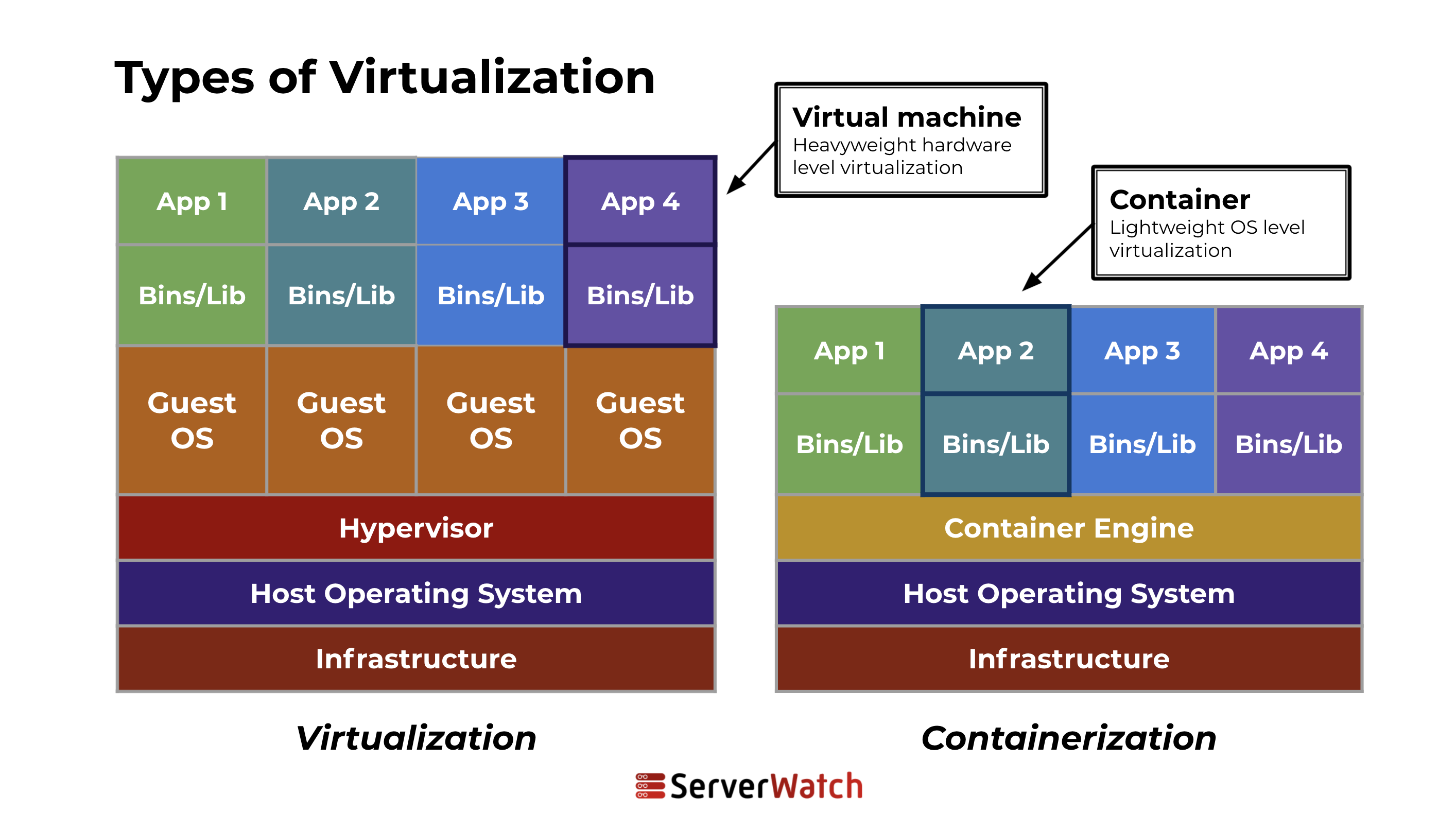Containerization is the solution to the roadblocks posed by traditional virtualization. Since their inception, virtual machines (VMs) have enabled organizations to do more with less. A single physical device can contain several isolated, virtual environments through a hypervisor, and the benefits include reduced overhead, convenient mobility, and scalability.
Sounds great – but there’s one problem. Virtual machines are heavy units.
Because a significant appeal of virtualization is its use in DevOps, the ability to store and migrate applications between platforms is essential. Coming in to fill this gap is virtualization’s younger, lightweight brother: containers.
What Is a Container?
A container, or application container, is an isolated computing environment in which programs are stored and accessed. Containers are a favorite for contemporary software development and deployment for two reasons.
- Containers are isolated, immutable, and easy-to-use environments for software testing akin to a sandbox.
- Containers offer flexibility and portability for quickly migrating applications across infrastructure environments.
Whereas virtual machines offer a complete hardware system simulation, containers only emulate the operating system. For the layman, this means containers only virtualize the OS and not a computer’s entire physical infrastructure like disks, drives, and server equipment.
Containers vs. Virtual Machines
In virtualization, two frameworks have emerged for modern networks: virtual machines and containers. Neither is mutually exclusive, and both facilitate moving one physical device’s contents to another. The crucial difference and advantage for containers is their size — or lack thereof.

With a VM’s applications, bins and libraries, and the guest OS giving it hardware-level virtualization, a virtual machine takes up gigabytes (GB) of space. By comparison, containers will often contain only a single application and have a footprint in megabytes (MB).
Read more about how servers virtual machines and containerization differ in our Guide to Virtualization vs. Containerization.
Container Use Cases
Application Modernization
Modernizing applications today means migrating programs from legacy on-premises deployments to cloud solutions. Because containers are agile, they enhance an organization’s ability to migrate applications and workflows seamlessly. Immutable across environments, containers enable organizations to use the synergy of DevOps to develop and deploy applications more quickly.
DevOps
The DevOps model is a paradigm shift for software providers. By joining development and operations engineers, organizations enable a faster-paced service delivery model. Whereas before developers and operations teams split work between devices, operating systems, and process steps, containers bridge the gap. This allows an organization to build, test, and ship its services more efficiently.
Deploying Microservices
The microservices architecture allows software developers to produce applications made up of several independent deployable services. Different components of the application hosted in containers are scalable and amenable to updating without disrupting other services.
Hybrid and Multi-Cloud
The modern organization infrastructure balances on-premises appliances, private cloud operations, and (potentially) multiple public cloud platforms. As organizations adopt this diversified approach, containers prove to have several benefits:
- Lightweight design for quick migration
- Container orchestration platforms like Kubernetes for automated management
- Environment stability is flexible for evolving workloads
While virtualization is hot, hybrid infrastructure is the future. We look at the state of organization infrastructures, and which workloads go where between on-prem, public cloud, and private cloud environments.
Read more about why On-Prem Infrastructure is Here to Stay
Container Industry and Vendors
A handful of estimates show the global application container industry was worth around $1 billion in 2018. Market research projects those numbers to climb to over $4 billion by 2023 and $8 billion by 2025. Market segments for the container industry include:
- Data management
- Consulting
- Monitoring
- Orchestration
- Security
- Support
Container Vendors
Container orchestration services remain a leading revenue segment as organizations attempt to manage a fleet of new containers serving ever-evolving networks. Leading cloud service providers like AWS and Azure have quickly offered cloud-based container management services (CaaS). At the same time, virtualization specialists VMware, Red Hat, and Docker continue to impress industry leaders.
Amazon Web Services (AWS)
As the dominant cloud service provider, Amazon Web Services (AWS) also offers many container solutions. Features AWS offers include running Kubernetes clusters, building microservices, and migrating existing applications.
Docker
Docker, Inc. employs PaaS products based on its open-source technology, Docker, for containerization. Started in 2008, Docker has been so dominant in the container space that its flagship name is almost synonymous with containers themselves.
Google Cloud Platform (GCP)
Informed by the rise of Docker and responsible for developing Kubernetes technology, the Google Cloud Platform (GCP) offers the Google Engines for Containers, Kubernetes, and Compute for virtualization management.
Microsoft Azure
Second only to AWS in cloud service market cap, Azure’s container technology ranges from cloud-scale job scheduling to fully managed OpenShift clusters and microservice orchestration. Solutions include Azure Kubernetes Service (AKS), Container Instances, Service Fabric, and more.
Red Hat
Acquired by IBM in 2019 for a whopping $34 billion, Red Hat’s line of open-source and enterprise software is well known, along with its relationships with top industry players. Only behind Google in contributing to Kubernetes code, Red Hat’s container solution is the industry-respected OpenShift.
VMware
Without VMware, it’s hard to imagine what commercial virtualization would look like today. For containerization, VMware’s Tanzu software brings Dev and Ops teams together to secure communication between apps, automate container management, and modernize apps fast.
Considering a container service with added security? Check out this list of 2021’s Top Container Security Solutions.
Containers Are Gaining Ground Against VMs
Containers are a proven method for employing virtualization for enterprises of all sizes. While virtual machines are still the favorite for enterprise and critical workload virtualization, containers are gaining ground.
The truth is both virtualization techniques complement each other. Virtual machines address infrastructure by enabling portability of resource-heavy applications and enhanced server utilization. Containers address application development by facilitating DevOps and microservices. Combined, organizations can optimize these innovations with a hybrid approach to virtualization.
Also read: Best Server Virtualization Software for 2021

